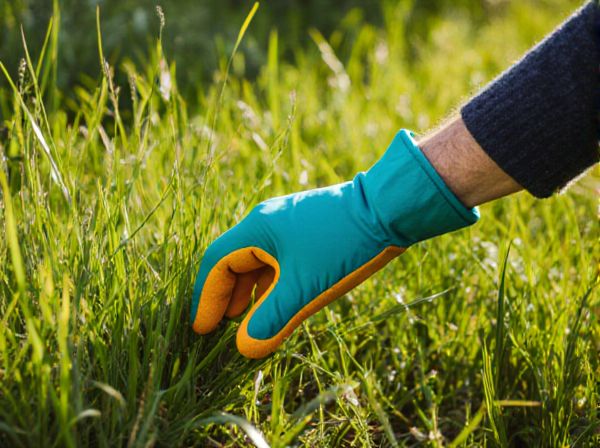
Crabgrass vs Quackgrass Illustration
Crabgrass and quackgrass are common lawn weeds that differ significantly in growth patterns and control methods. Crabgrass thrives in warm seasons with sprawling stems and broad leaves, making it easier to manage with pre-emergent herbicides and regular mowing. Quackgrass spreads aggressively through underground rhizomes, requiring persistent treatment and often a combination of mechanical removal and systemic herbicides for effective eradication.
Table of Comparison
| Feature | Crabgrass | Quackgrass |
|---|---|---|
| Type | Annual weed | Perennial weed |
| Growth Habit | Spreads by seed | Spreads by rhizomes |
| Leaf Shape | Wide, hairy blades | Narrow, smooth blades |
| Color | Light green to purple edges | Dark green |
| Root System | Fibrous | Extensive rhizomes |
| Control Methods | Pre-emergent herbicides, mowing | Systemic herbicides, root removal |
| Impact | Invades lawns fast, competes for nutrients | Hard to eradicate, damages turf roots |
Identifying Crabgrass and Quackgrass: Key Differences
Crabgrass exhibits wide, flat leaves with a coarse texture and grows close to the ground in a sprawling pattern, while Quackgrass features narrower, hairless leaves with a pointed tip and spreads through extensive underground rhizomes. Crabgrass typically appears in warm seasons and thrives in disturbed or compacted soils, whereas Quackgrass is a perennial that emerges in cooler seasons and can invade lawns and gardens aggressively. Identifying these differences in leaf shape, growth habits, and seasonal appearance is critical for effective weed management strategies.
Growth Habits of Crabgrass vs Quackgrass
Crabgrass thrives as a warm-season annual weed with a prostrate growth habit, spreading rapidly through seed production and rooting at stem nodes. Quackgrass is a perennial with aggressive rhizomatous growth, allowing it to spread underground and form dense, interconnected mats. The extensive root system of quackgrass makes it more difficult to control compared to the shallow-rooted crabgrass.
Lifecycles: Annuals vs Perennials
Crabgrass is an annual weed that completes its lifecycle within one growing season, germinating in spring and dying off with the first frost. Quackgrass is a perennial, spreading through rhizomes and surviving underground during winter months to regrow each year. Understanding the annual nature of crabgrass and the perennial persistence of quackgrass is crucial for implementing effective weed management strategies.
Visual Characteristics: Blades, Color, and Seed Heads
Crabgrass features wider, lighter green blades with a coarse texture, while quackgrass has narrower, darker green blades with a smoother surface. Crabgrass seed heads typically fan out with finger-like projections, contrasting with the quackgrass seed heads that form dense, spike-like clusters. These distinct visual characteristics assist in identifying and managing each weed effectively.
How Crabgrass and Quackgrass Spread in the Garden
Crabgrass spreads in the garden through lightweight seeds that germinate quickly in warm soil, often exploiting bare or disturbed patches. Quackgrass propagates primarily via aggressive underground rhizomes, allowing it to form dense mats that choke out desirable plants. Understanding these distinct spreading mechanisms aids in targeted weed management strategies for maintaining healthy gardens.
Impact on Lawn Health and Competition with Desirable Grasses
Crabgrass aggressively invades lawns, outcompeting desirable grasses by rapidly spreading through seeds and creating dense mats that block sunlight and nutrients. Quackgrass, with its deep rhizomes, competes more persistently by drawing moisture and nutrients away from turfgrass roots, often causing thinning and weakening of lawn health over time. Both weeds reduce lawn vigor, but quackgrass's perennial nature makes it harder to control and more damaging in the long term.
Effective Prevention Techniques for Both Weeds
Crabgrass prevention relies heavily on early spring application of pre-emergent herbicides to stop seed germination, while maintaining thick, healthy turf through proper mowing and watering can reduce bare spots that invite infestation. Quackgrass control requires a combination of systemic herbicides targeting rhizomes and cultural practices like deep tillage and crop rotation to disrupt extensive root systems. Regular lawn maintenance and prompt weed identification enable timely intervention, minimizing the spread of both aggressive weeds in residential and agricultural settings.
Organic and Chemical Control Methods Compared
Crabgrass and quackgrass can be managed effectively through a combination of organic and chemical control methods tailored to their growth habits. Organic control involves manual removal, mulching, and the use of natural herbicides like vinegar or corn gluten meal, which inhibit seed germination without harming beneficial soil organisms. Chemical control typically employs pre-emergent herbicides like pendimethalin for crabgrass and glyphosate or selective broadleaf herbicides for quackgrass, targeting root systems and preventing regrowth more aggressively.
Seasonal Timing for Managing Crabgrass and Quackgrass
Crabgrass thrives in warm-season conditions, germinating primarily in late spring when soil temperatures reach around 55degF, making early pre-emergent herbicide application critical for effective control. Quackgrass, a cool-season perennial, emerges early in spring and sustains growth into fall, requiring late summer or early fall treatments to target its rhizome system effectively. Timing herbicide applications to these seasonal growth patterns enhances weed management success by disrupting the life cycle of each species.
Restoration Tips for Lawns After Weed Removal
Effective lawn restoration after removing crabgrass or quackgrass involves thorough soil aeration to improve nutrient absorption and promote healthy grass growth. Applying a high-quality, slow-release fertilizer enhances root development and helps establish a dense, resilient turf. Overseeding with native or well-adapted grass species ensures faster recovery and reduces the likelihood of weed re-infestation.
Crabgrass vs Quackgrass Infographic

 gardendif.com
gardendif.com